US Navy Uniform Profile
Enlisted Men's Dress, Blue, A & B Uniform
(1941-1945)
Point or touch screen for explanation of images below.
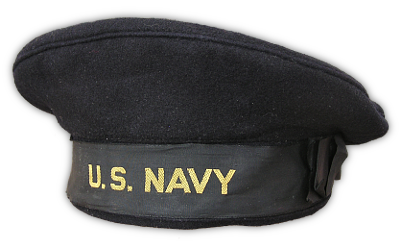
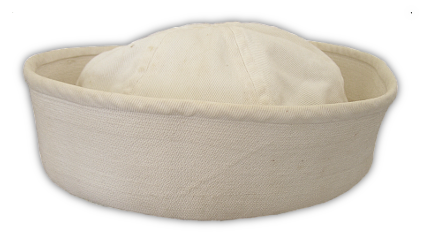
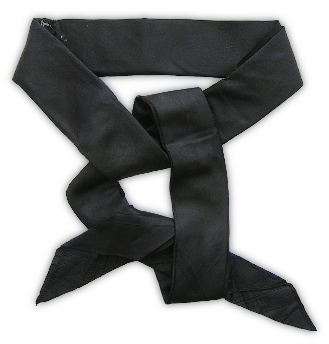
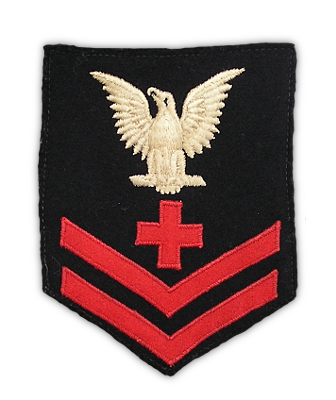
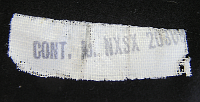
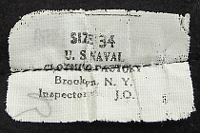
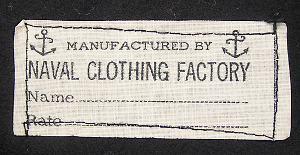
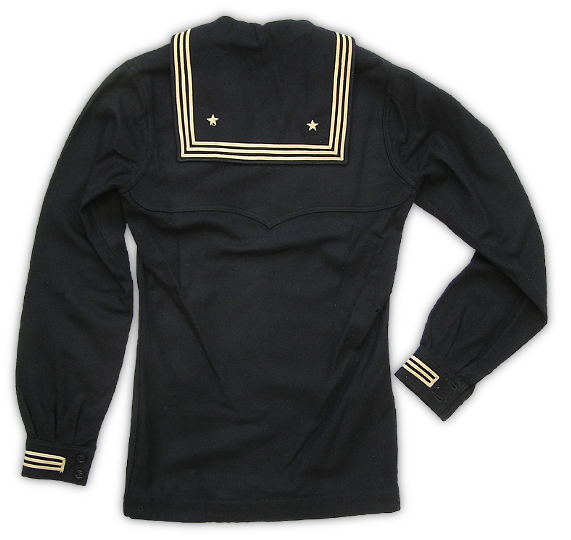
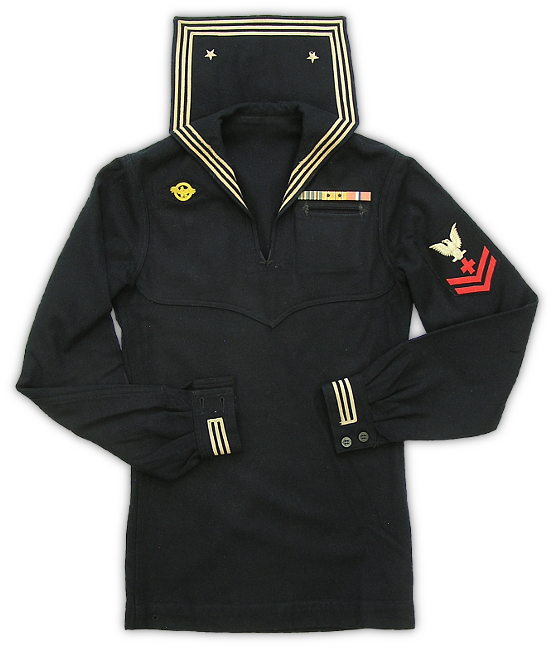
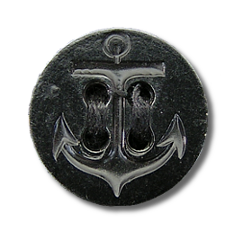
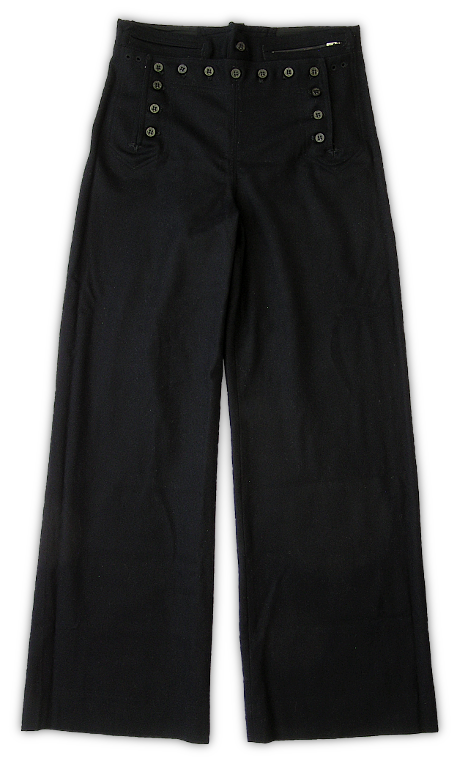
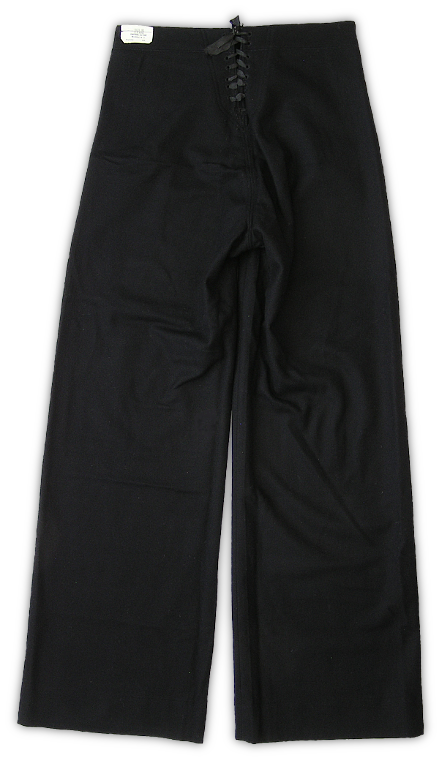
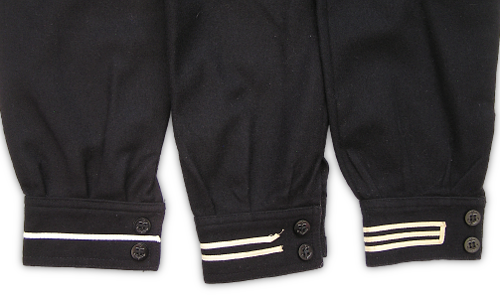
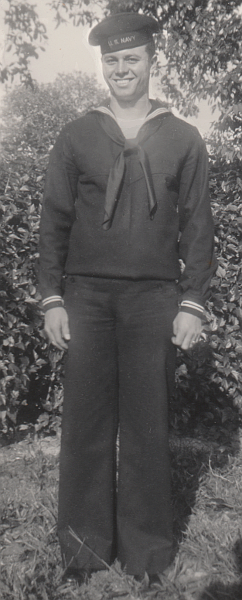
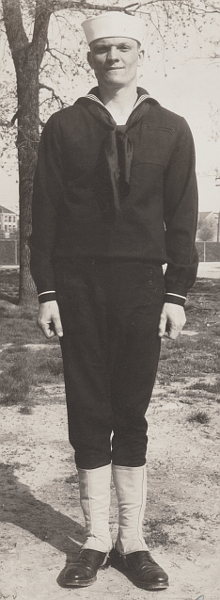
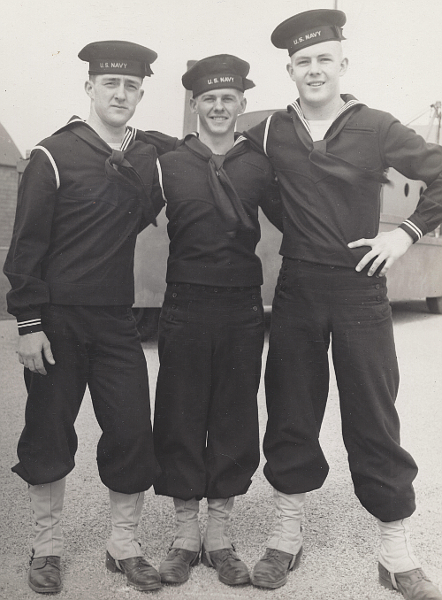
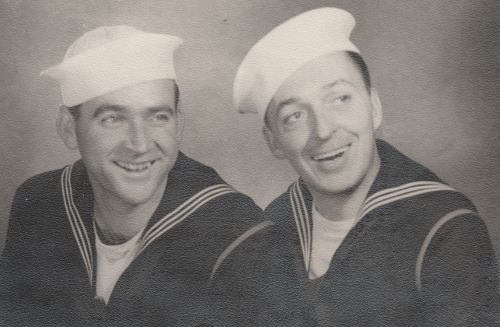

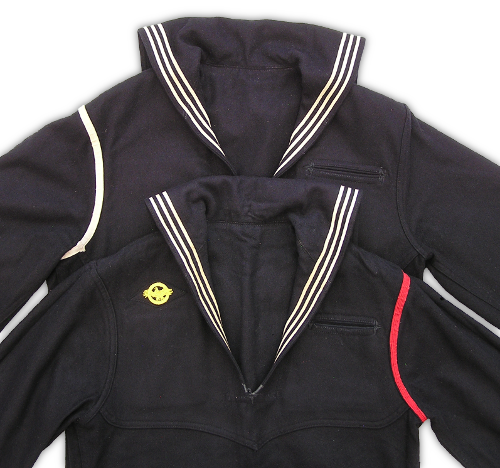
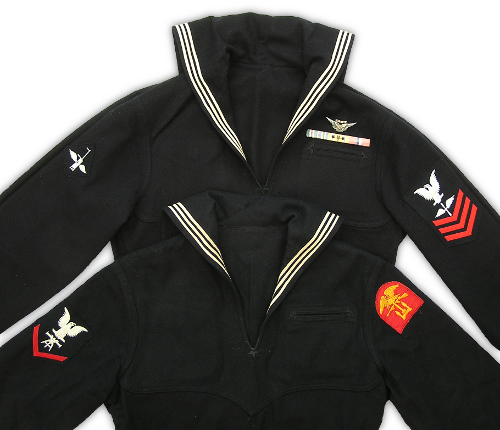
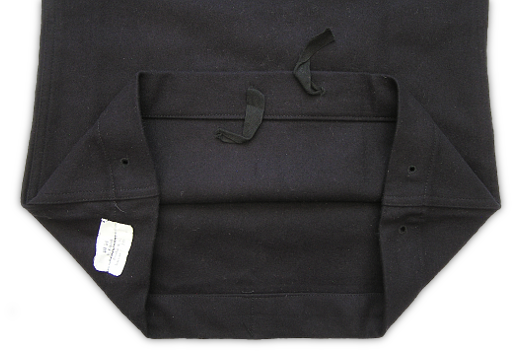
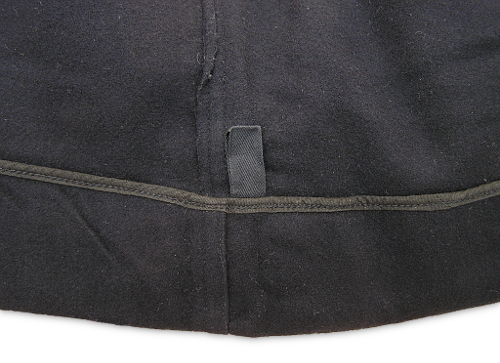
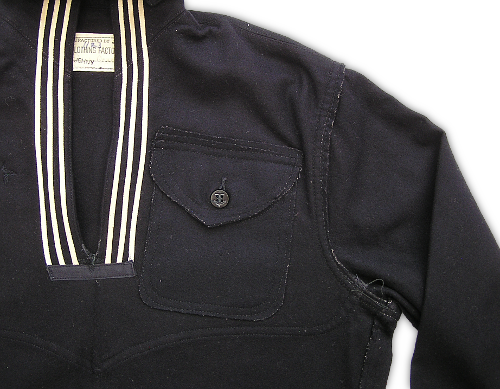
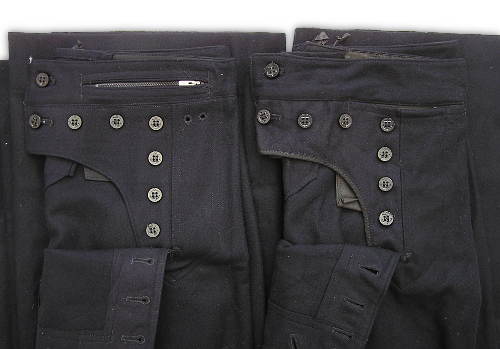
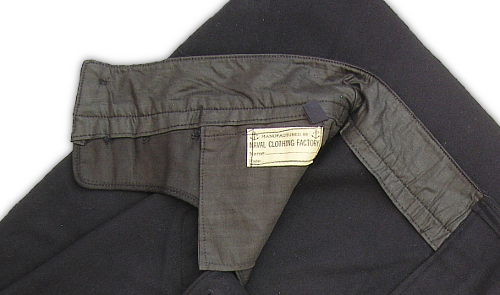
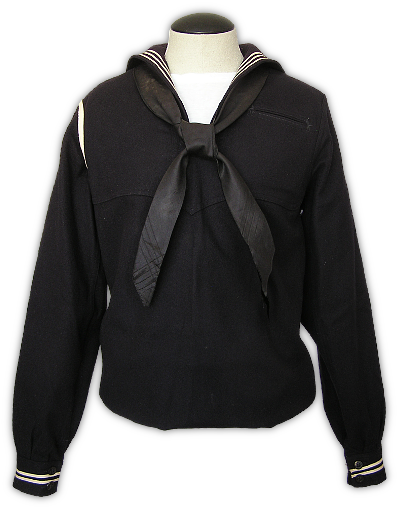
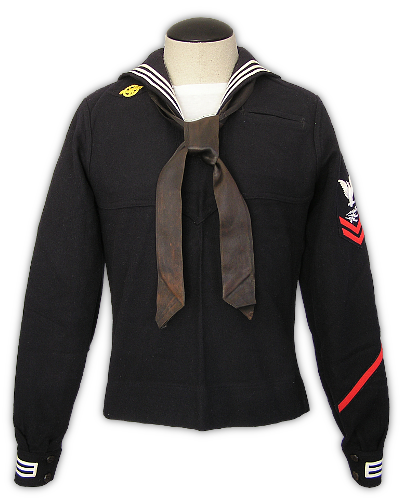
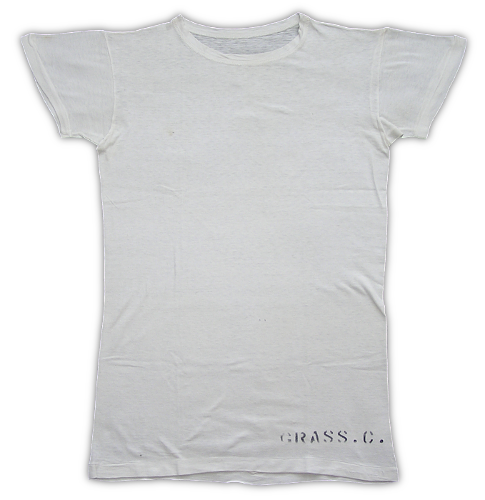
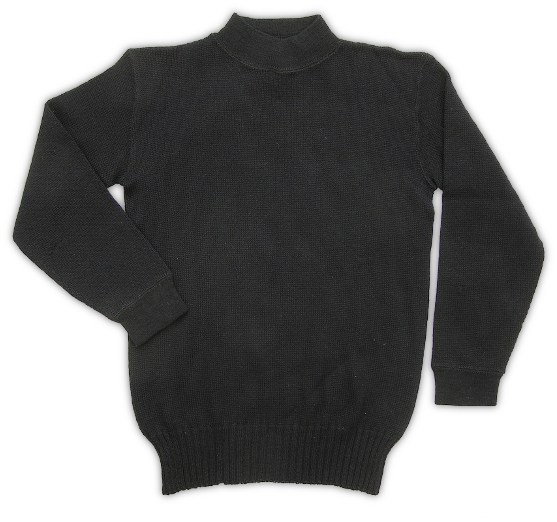
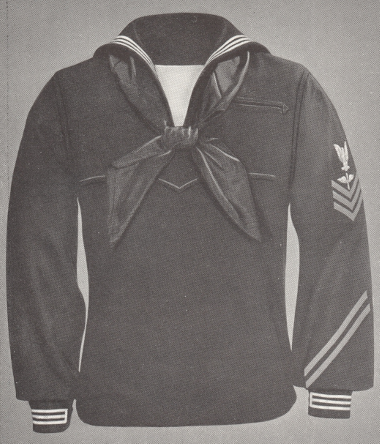
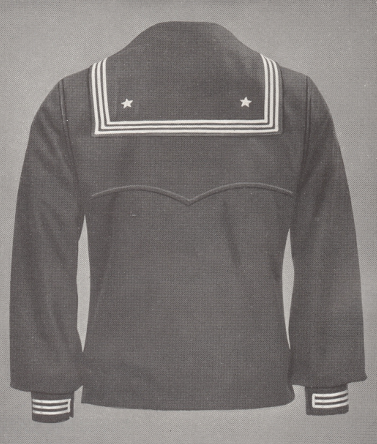
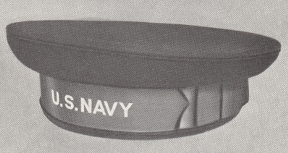
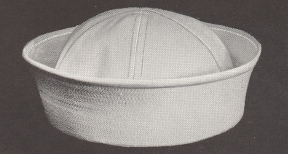
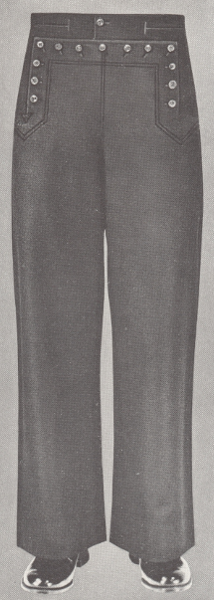
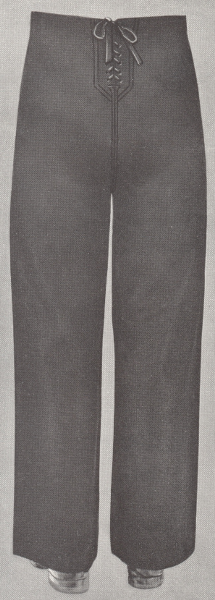
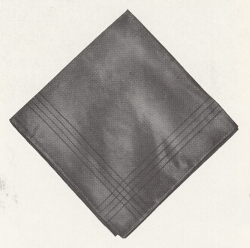
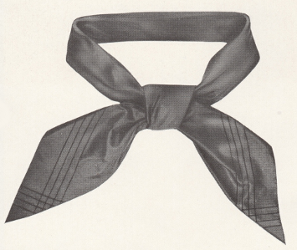
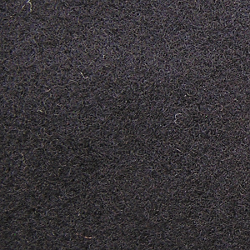
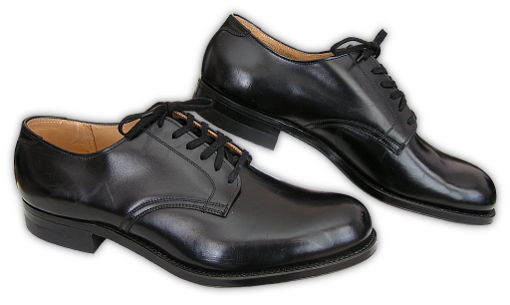
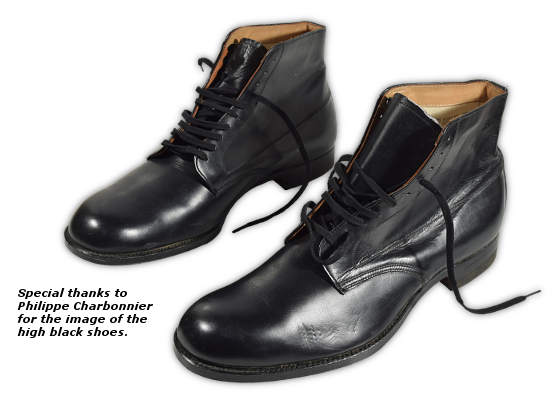
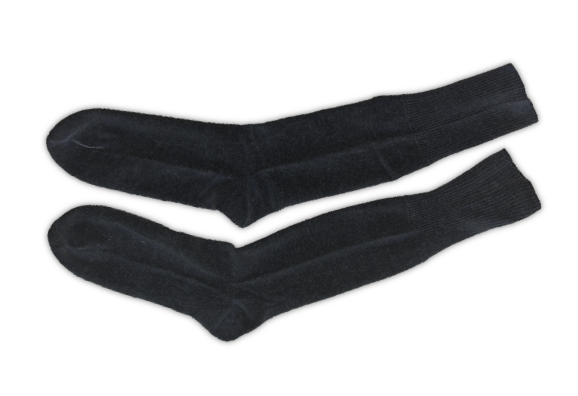
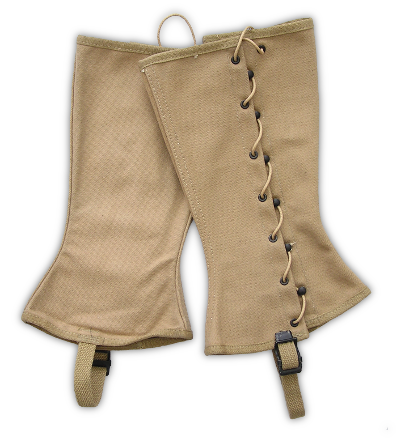
US Navy Enlisted Men's Blue Dress A & B Uniform
Introduction
The venerable dress blues have been in service for over one hundred-fifty years and are still worn today. On a couple of occasions the Navy tried to replace the uniform. First, in the mid-40s, an "Ike" style uniform featuring a short jacket was tried out and was soundly rejected after its trial period. Then, between 1973 and 1980 the uniform was, in fact, briefly replaced with a more contemporary suit and visor cap design only to return to the tried-and-true dress blues. The uniform's main qualities of comfort, practicality, and a distinctive design have endeared it to the sailor. Iconic in appearance, the primary WW2 dress blue outfit consisted of a beret style cap with a ribbon and bow around the band; a "V" neck jumper with a square sailor's collar; a silk neckerchief; and bellbottom trousers with a 13-button broadfall front. Although its design features evolved from needs that had long since passed into history and were archaic even by WW2 standards, the uniform provided the sailor with an instantly recognizable uniform that boosted morale, evoked esprit de corps, and honored the Navy's proud history.
Photos dating back to at least the early 1860s show US sailors wearing a blue wool uniform not too different from the WW2 design. Through much of its early years the uniform was worn at sea, but by WW2 it had become mainly a dress uniform used for more formal occasions, such as in formation, ceremonial activities, or for special guard duty. It was also worn on shore leave in appropriate climates. In fact, during WW2 it is most often seen being worn in northern shore and training stations by new inductees. The shift from a practical working uniform to one used for dress occasions was inevitable as military doctrine was evolving during the 1930s and 40s by setting specific roles for uniforms and establishing clear distinctions between work, garrison, and combat attire. And, certainly, by the end of WW2 the age multi-use uniforms had passed.
Men of all ranks in the Navy wore a version of the dress blue uniform, but it should be pointed out that the type of uniform shown here was only worn by enlisted men below the rank of Chief Petty Officer. Commissioned Officers, Warrant Officers, and Chief Petty Officers had their own wardrobe of dress and working uniforms specific to each of them. The WW2 dress blue jumper and trouser combination was considered a winter uniform to be worn in cool temperatures. It was constructed of high quality 16-ounce Melton wool that had a fine nap and was relatively soft to the touch. There were appropriate accessories to keep sailors warm on colder days. These included an overcoat made of matching heavy-weight Melton, blue wool knit gloves, and a blue wool muffler. The Dress Blue Uniform was included as part of the enlisted man's initial clothing gratuity. In northern training stations it was issued at induction and in warmer areas not until graduation was complete and final assignment received.
The dress blue uniform underwent continuous refinement over the decades of its use as was typically the case with uniforms that existed for any length of time. This process continued during WW2 with some significant changes being made to the jumper and trousers at the end of 1943. At this time it was decided to shorten the length of the jumper by six inches and simplify the waistband area of the trousers. These changes were implemented primarily to realize savings in a wartime economy by reducing the amount of fabric required to make the uniform and to speed up production by simplifying the manufacturing process.
The dress blue uniform could be worn in a couple of different configurations depending on what uniform was prescribed for the day by the senior officer present. These differences centered on the type of hat or cap worn with the uniform and whether ribbons or medals were to be applied. For the most part, either a blue wool cap or a white cotton hat was worn along with ribbons. Whichever uniform that was prescribed, Commissioned Officers, Warrant Officers, and Chief Petty Officers wore their corresponding blue uniforms with a like colored cap. There were three official designations for the enlisted man's dress blue uniform cited in the 1941 Uniform Regulations and are listed below:
- Dress, Blue, A. - Blue dress jumper, ribbons, blue trousers, blue cap, neckerchief, black shoes, and black socks.
- Dress, Blue, B. - Same as Dress, Blue, A, but with white hat.
- Full Dress, Blue. - Same as Dress, Blue, A, but decorations, medals, and badges shall be worn when Full Dress, Blue is prescribed for officers.
The dress blue uniform could also be worn with high-top shoes and canvas leggings giving it yet another distinctive look. Under most circumstances, however, low-quarter shoes were worn. Situations requiring high-top shoes and leggings were set forth in Navy regulations, which stated: "Leggings shall be worn by enlisted men of the Navy with any form of dress when under arms for parade or ceremony, for infantry or artillery drill, when in a landing party, or on guard detail, or when on duty ashore as patrol or beachmaster's guard, or as mail orderly".
Each enlisted man was issued a minimum outfit of clothing upon entering the Navy that consisted of work, dress, and utility uniforms. This initial issue was called a clothing gratuity because the items were given out at the Government's expense. The number of items in the gratuity or the time at which certain items were issued could be changed at the discretion of the commanding officer. A listing of items and the quantity issued for the dress blue uniform components covered in this Uniform Profile are listed below and are from the 1941 Navy Uniform Regulations:
- White Hat - 3
- Blue Cloth Cap - 1
- Blue Dress Jumper - 1
- Neckerchief - 1
- Jersey - 1
- Leggings (Pair) - 1
- Low Black Shoes - 1
- High Black Shoes - 1
- Woolen Socks - 2
- Blue Trousers - 2
- Undershirts (Light or Medium) - 4
The uniforms depicted within this profile page are the types issued by the Navy as part of the enlisted man's uniform gratuity. However, sailors often purchased their own tailor made dress blue uniforms, which was permitted by Navy Regulations. Though private purchase uniforms were required to meet Navy specifications, they were usually made out of gabardine wool, had some type of lining, and sometimes had additional inside pockets. When the shortened jumper came into being, it was also popular to have a hidden zipper installed along the left side seam to help make getting it on and off easier. Many custom outfits were embellished with colorful embroidering added to the inside lining of the jumper. This was usually done with prefabricated pieces, but sometimes the designs were embroidered directly to the lining. This type of custom work, popular in the Pacific Theater, usually depicted mythological creatures, such as dragons or mermaids; or sometimes fish, dolphins, or even flags. The most common application was to the inside of the jumper cuffs and was referred to as liberty cuffs because they could be turned up to display the image when being worn on liberty. These colorful images can also be found applied to the inside back of the jumper and on the back side of the square sailor's collar.
Between WWI and WW2, enlisted men's dress blue jumpers and trousers were made in their entirety at the Naval Clothing Factory in Brooklyn, New York. The primary purpose of this Navy owned facility was to control the cost of enlisted men's uniforms, which were issued at the Government's expense. Once the ramp-up to WW2 began, the need for uniforms easily outpaced the Naval Clothing Factory's ability to produce them. As a result, large numbers of dress blue jumpers and blue trousers were manufactured by the garment industry via contracts issued by the Navy's Bureau of Supplies and Accounts. All Navy issued blue jumpers and trousers had a permanent "Manufactured By Naval Clothing Factory" label whether the garment was actually made there or not. For the jumper this label is found on the nape underneath the square sailor's collar and for the trousers it is on the inside attached to the right pocket. There was also a temporary label attached to the jumper and trousers used for the size tariff, contract number, and inspector's initials. For the jumper, this label was on the right, rear bottom hem and for the trousers it was on the left, rear waistband. If the garment was made by an external contractor, the contract number appeared on the reverse side of this label.
During the WW2 period, enlisted men of the US Coast Guard and the US Maritime Service essentially wore the same dress blue uniform as the Navy did. Differences, if at all, were very minor. Coast Guard procured items will have labels in the same locations as those found on Navy items except that they will have "U.S. COAST GUARD" printed on them instead of U.S. Navy. Sometimes, though, in order to meet their uniform requirements, the other seagoing services used Navy procured and marked jumpers and trousers. Ribbons on the blue cap, however, were always embroidered with "U.S. COAST GUARD" or "U.S.M.S." to properly identify the service.
Cap & Hat
The Dress Blue A & B designations referred to the color of headgear to be worn with the uniform and applied to all men in the Navy. Dress Blue "A" meant blue headgear and Dress Blue "B" meant white headgear. A third designation called Full Dress Blues required blue headgear and full size medals and badges to be worn on the uniform. For the enlisted man below the rank of Chief Petty Officer, this meant the dress blues were worn with the Blue Cloth Cap and the White Hat respectively. The blue cloth cap was made in a beret style with the same 16-ounce Melton wool used for the jumper and trousers. It had a silk ribbon around the band with a bow tacked to the left side. The ribbon was embroidered with "U.S. NAVY" or "U.S. NAVAL RESERVE" in yellow block letters. Wear of the Blue Cloth Cap was typically reserved for more formal occasions or when the weather was cooler. When the Dress Blue A or Full Dress Blues were prescribed for wear, Commissioned Officers, Warrant Officers, and Chief Petty Officers wore their corresponding Dress Blue A Uniforms with a blue Combination Cap. The more familiar White Hat, sometimes referred to as a sailor's hat or "Dixie Cup" because of it shape, was worn much more often than the blue cap. Made of bleached cotton drill, the white hat had a rounded crown made of six triangular segments and a full brim stiffened throughout with rows of stitching. This hat was designed for warm and hot conditions and could be worn with the brim turned up or down, but with the dress blues it was worn in the up position. Because of the White Hat's versatile design it was also worn with a number of other uniforms in addition to the dress blues. The white hat projected a more relaxed appearance when worn with the dress blues. The white color provided an excellent contrast to the dark blue wool while at the same time accentuating the white tapes on the jumper and white undershirt visible at the neckline. When the Dress Blue B uniform was prescribed, Commissioned Officers, Warrant Officers, and Chief Petty Officers wore their corresponding Dress Blue B uniforms with a white cover on the combination cap.
Jumper, Neckerchief & Insignia
The WW2 era dress blue jumper was a pullover blouse made of 16-ounce dark blue Melton wool, which was described by the Navy as "a stout, smooth woolen cloth with a short nap". The yoke was made with a double layer of material and had a stylized seam coming to a downward point at mid-chest creating a design reminiscent of a ship's bow parting the ocean. A number of prominent features marked the jumper including a square sailor's collar; a V-neck; a small slit pocket above the left breast; an inside patch pocket with a flap and button located on the right chest; and shirt-style cuffs with each having two 25-line plastic anchor emblem buttons. Three lines of White tape and two stars adorned the collar as did white tape on the cuffs making the dress blue jumper easily distinguishable from its similar looking, but unadorned, cousin called the Undress Blue Jumper.
Perhaps the most prominent feature of the dress blue jumper is its large, square sailor's collar. Both the collar and the neckerchief worn around it have their origins in the early days of the Navy when long voyages at sea meant sailors, for the most part, wore long hair. Hair was braided into a pigtail and tarred to hold it together in order to keep it from being tangled in equipment. To keep the uniform clean, a detachable collar or handkerchief was permitted as a barrier between the uniform and hair. The three white stripes and the stars on the collar came into being for decorative purposes. The stars appeared on all uniform jumpers beginning in 1820. Collar stripes were being worn in the early 1860s but were not standardized until 1876 when the number was set at three for all sailors.
In addition to being used as a barrier that separated the sailor's clubbed and tarred hair from the uniform, handkerchiefs were also originally used as a bandana to keep sweat out of the eyes. By WW2 however, the neckerchief was purely for adornment and its wear was strictly governed by regulations. The dress blue jumper and neckerchief were integral components that were always worn together. Measuring a 36 inch square, it was first folded diagonally, then rolled, and tied with a square knot that was to be situated so that the top of the knot was level with the bottom of the "V" neck opening. Regulation neckerchiefs were made of black silk and had four lines around the perimeter. These lines were a decorative design and did not have any special meaning. During WW2 it was common for sailors to have their neckerchiefs altered or to purchase imitations that were designed to skip the folding and rolling process and be easier to put on. This was done by folding the scarf into a similar position as it would appear rolled, tacking it in place, and then flattening it. Some commercial types were simply a scarf in the shape of a rolled neckerchief that was then tied around the neck. These types of neckerchiefs were referred to as "shoe-string" neckerchiefs by the Navy and were officially banned in the post-war era.
Unlike the ornamental tapes and stars applied to the sailor's collar, cuff tapes had meaning beyond their decorative appeal as they represented the first three rates for the enlisted man. Rate is the term the Navy uses to refer a man's rank. Early-war dress blue jumpers had either one, two, or three cuff stripes made of 3/16-inch-wide white tape. Seamen and Firemen First Class and Petty Officers 1st, 2nd, and 3rd class wore three white stripes; Seamen second class and Fireman second class wore two white stripes; Apprentice seamen wore one white stripe. The following chart compares Navy rates with Army ranks to help give a better of understanding of the Navy's hierarchy of rates:
| Navy Rate | Army Rank |
|
Apprentice Seaman; One cuff stripe. |
Private; No insignia. |
| Seaman 2nd Class; Two cuff stripes. |
Private 1st Class; One chevron. |
| Seaman 1st Class; Three cuff stripes. |
Corporal; Two chevrons. |
| Petty Officer 3rd Class; Three cuff Stripes, one chevron. |
Sergeant; Three chevrons. |
| Petty Officer 2nd Class; Three cuff stripes, two chevrons. |
Staff Sergeant; Three chevrons, one rocker. |
| Petty Officer 1st Class; Three cuff stripes, three chevrons. |
Technical Sergeant; Three chevrons, two rockers. |
During the pre and early war years, jumpers were issued brand new with one cuff stripe and additional stripes were added as the sailor progressed. By 1944, production of one stripe jumpers was halted for the duration of the war and replaced with jumpers bearing two stripes in order to ease supply problems.
Enlisted men below the rank of petty officer wore stripes around the shoulder of their dress blue jumpers called Branch Marks. These stripes were made of ⅜-inch-wide white or red braid. Men assigned to the Seaman Branch wore a white braid on the right shoulder and men assigned to the Artificer Branch (Engine Room Force) wore a red braid on the left shoulder. Branch Marks were worn until the rank of Petty Officer was achieved, after which a Rating Badge was worn on the sleeve of the jumper.
Petty Officers 1st, 2nd, and 3rd class wore rating badges on the sleeve of their dress blue jumpers between the shoulder and elbow. From top to bottom, the badge consisted of an eagle, specialty mark, and chevrons on a blue background. The eagle and Specialty Mark were white and the chevrons red. Third class Petty Officers wore one chevron, Second Class Petty Officers two chevrons, and First Class Petty Officers three chevrons. Depending on the branch of service, the rating badge was worn on either the left or right sleeve. For the seaman branch, the rating badge was worn on the right sleeve and for all other branches it was worn on the left sleeve. During the WW2 era, the Seaman Branch included men with the rating of Boatswain's Mate, Coxswain, Turret Captain, Gunner's Mate, Torpedoman's Mate, Quartermaster, Signalman, Fire Controlman, and Mineman. Branches that wore the rating badge on the left arm and some of the rates that existed within them included the Artificer Branch (Radioman, Radarman, Carpenter's Mate, Shipfitter, Metalsmith, Sonarman); Artificer (Engine Room Force) (Machinist's Mate, Electrician's Mate, Boilermaker, Water Tender); Aviation Branch (Torpedoman's Mate, Aviation Machinist's Mate, Aviation Radioman, Aviation Ordnanceman, Parachute Rigger); Commissary Branch (Commissary Steward, Ship's Cook, Baker); Special Branch (Yeoman, Storekeeper, Pharmacist's Mate, Bugler, Printer); Steward's Branch (Steward, Cook, Steward's Mate); and Specialists (Athletic Instructor, Mail Clerk, Recruiter, Shore Patrol, Teacher). Touch icon below for images of specialty marks:

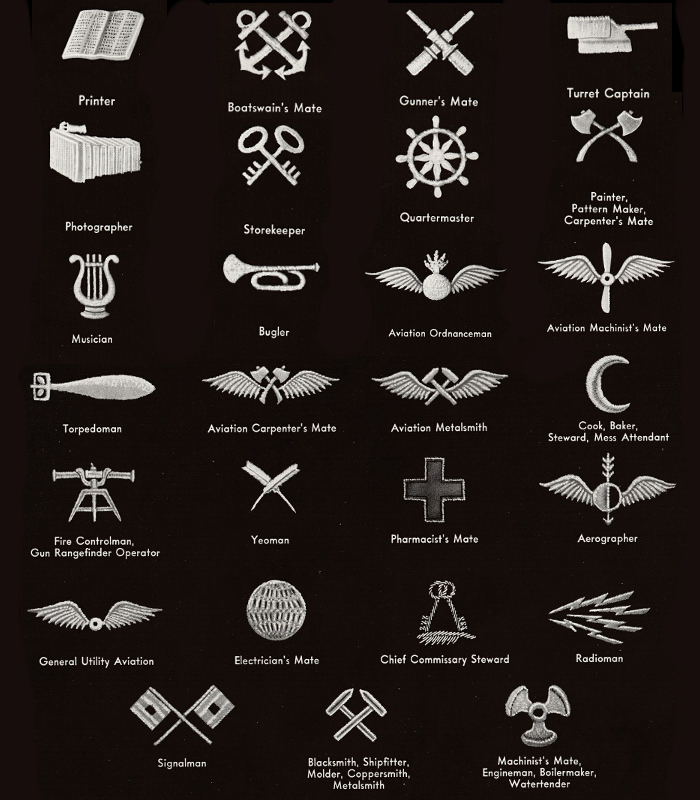
The specialty marks shown above are illustrations from the 1941 Navy Uniform Regulations. These marks appeared underneath the eagle on the rating badges of petty officers. Some of these marks also doubled as Distinguishing Marks as well, and when this was the case they would not be part of a rating badge and would appear on the jumper by themselves. The number of specialty marks and the symbols used for them increased dramatically during WW2.
Another type of insignia that appears on the blue jumper is called a Distinguishing Mark and is similar to the Specialty Mark on the Rating Badge. This insignia consists of a white embroidered symbol on a blue background that represents some skill or personal achievement the sailor has attained. Each type of distinguishing mark had a specific place on the jumper that was governed by regulations. Thus, these marks can be found on either the left or right sleeve and can be on the upper or lower portion of the sleeve. Some examples include the Submarine Insignia, Signalman, and the Air Gunner (seen in one of the photos above). Some Specialty Marks doubled as Distinguishing Marks, such as Gun Range Operator and Radioman. Certain units within the Navy were entitled to wear shoulder sleeve insignia at the top of the left arm. This was a patch having a specific design representing the unit in which the sailor was attached and was similar to those routinely worn on Army and Marine Corps uniforms. Navy units that were entitled to wear shoulder sleeve insignia included the Amphibious Forces, Construction Battalions, PT Boats, and Mine Layers. Touch icon below for images of distinguishing marks:

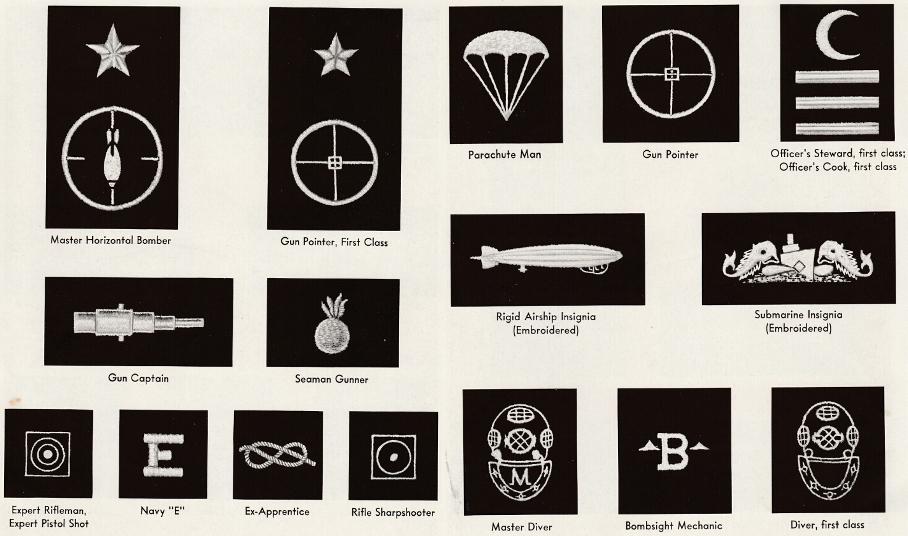
The distinguishing marks shown above are illustrations from the 1941 Navy Uniform Regulations. Each distinguishing Mark had a specific location on the jumper that was set by regulation. This could be on the upper or lower portion of either sleeve. Like specialty marks, the number of different distinguishing marks increased during the WW2 period.
Ribbons were worn in rows above the left chest pocket with each row having up to three individual ribbons. Both the Dress Blue A and Dress Blue B uniform were worn with ribbons. Ribbons were to be applied to the uniform in a specific order of precedence with the highest ranked beginning at the top and proceeding from left to right (when viewed from the front) toward the bottom. Medals were worn in the same location and fashion as ribbons and when prescribed the uniform designation became Full Dress Blues. Badges were worn above ribbons and medals on the left chest.
In December 1943, the Navy announced that the blue dress jumper would be shortened by six inches. This modification was expected to improve the appearance of the uniform while at the same time realize a substantial savings in the manufacturing cost. Prior to the cut down, the jumper had a drawstring running through the bottom hem that was tightened around the waist with the remaining material bloused over the hips to cover the top of the trousers. The old jumper also had four eyelets located on the bottom hem that were used to lace laundry ties through for lashing to a clothes line. Two eyelets were located on each side of the jumper, one fore and aft of the side seams. Shortening the jumper meant that the drawstring and eyelets were replaced by a 2½-inch hem that could be let out to adjust for correct fit. On the new jumper there were two tape loops added to the inside hemline, one near each side seam for the purpose of stringing the laundry ties through. Once the short jumper became the acceptable standard, many of the older long jumpers were cut down into the short style. Clearly some of these older jumpers were modified at the expense of the individual sailor, but it is unclear whether the Navy, at any point in time, cut the older jumpers down too.
Trousers
Like the jumper, the WW2 blue trousers retained most of its traditional design features from the past and as a result had a very distinctive appearance in a time when uniform modernization was considered a priority. The same 16-ounce dark blue Melton wool was used for the trousers as it was for the jumper. A broadfall front opening and bellbottom legs were most prominent among a number of interesting features that these trousers possessed. There was a two button waistband closure with the bottom button doubling as the top, center button for the 13-button broadfall front. Buttons were the same 25-line plastic type with anchor emblem that was used on the cuffs of the jumper. Despite legend, the 13-button front was not to honor the original Thirteen American Colonies, but was simply the number needed to achieve symmetry when the flap was enlarged from a 7-button front in 1894. On each side of the front waistband there was a 4-inch slit pocket with the left pocket having a zipper closing. There were two eyelets on each hip located beside the flap opening that were used to string the trousers up on a laundry line. Located in the rear, depending on trouser size, was a 4½ to 5½-inch laced gusset that could be used to adjust the fit if needed. Legend and speculation also surround the true purpose of the bellbottom legs. It has been said that the wide legs were adopted so that the trousers could be taken off quickly while abandoning ship. This is not the case, however. Navy uniform historians have acknowledged that the use of bellbottoms originated from 1817 regulations requiring men to be barefoot and roll their pants up over the knees when swabbing the deck.
As was the case with the jumper, it was decided to modify the trousers in late 1943. These changes were not accompanied by the awareness campaign afforded the jumper and at first glance are not as obvious to the casual observer. Actions taken were designed to simplify production and improve the sizing and fitting of the trousers. The waistband area was modified by lowering the position of the pockets and removing the double sets of eyelets located beside the front flap. Both pockets were lowered from the center of the waistband to just below the waistband and were changed from double welt construction to single welt with this being accomplished by making use of the waistband seam for the top of the pocket opening. Two tape loops were added on the inside of the trousers for the laundry ties and were located at the waistband seam above the pockets. During this time the sizing tariff schedule was changed from a system were a waist size had a corresponding inseam length to one that combined a waist size measurement followed by either an S for short; M for Medium; or L for Long that represented the length of the trousers with unfinished bottoms. This change simplified the sizing system and allowed for a more exact fitting of the trousers by having each trouser hemmed to an exact fit.
Undershirt & Jersey
In most instances, a light undershirt was worn underneath the jumper. This garment was an integral part of the dress blue uniform because it was always visible unless an overcoat was being worn. The deep "V" collar of the jumper made wearing of an undergarment necessary and with the neckerchief being knotted just below the neck opening this area was a focal point of the uniform. Made with bleached cotton, the body of the undershirt was without side seams, had short-sleeves, a circular collarette, and there were four eyelets on the bottom hem, two on each side, for stringing clothing ties. Together, the undershirt, collar and cuff ornamentation, and white hat complimented each other while providing an excellent contrast to the jumper's dark blue fabric.
In colder weather, a dark blue knitted sweater was often worn under the dress blue jumper. The Navy simply referred to this garment as a Jersey (an older English word for a sweater with longsleeves, worn as a pullover). It was a close fitted, versatile garment that could be worn under most uniforms when needed and was a mandatory issue item in the enlisted man's prescribed outfit. Specifications called for the use of worsted wool, ribbed knit construction with no side seams, a racked bottom, double ribbed cuffs, and an elliptical collarette. The length was to come down to the top of the hips, but not below. A cloth label was located on the inside nape for writing the sailor's name and rate.
Shoes
A plain low black shoe was standard wear for the enlisted man's dress blue uniform. However, regulation Navy shoes could either be high (Type A) or low (Type B). Both were made in black chrome calfskin, constructed using a Goodyear welt, had leather outsoles, a plain toe, and followed a blucher pattern. Both shoes had a fabric lined toe box and the high-tops had lined quarters as well. The high black shoe was intended to be worn in situations requiring leggings, such as when under arms or when assigned to duties in the field. Late in the War, the high black shoe was revised into a sturdier shoe that was built more like the field shoe except for the outward finish. Even though the old and new high-top shoes looked virtually the same from a distance, they were very different shoes. The new shoe was unlined, made of full grain cowhide and had a full composition outer sole. With this revision came a name change from High Black Shoe to General-Purpose High Black Leather Shoes. Socks were black when worn with the standard Navy high or low black shoes.
Conclusion
The dress blue uniform was and still is a favorite of US Navy sailors. Multiple attempts to replace it, first in the mid-40s and again in the early-70s, failed. There were several reasons for this. First, the uniform has a distinctive, instantly recognizable appearance that instills pride in the Navy and its history and traditions; Second, its unsurpassed comfort allows easy movement; Third, its side seams and creases allow it to be rolled flat and easily stored in small spaces, such as a ship's locker or a seabag, and still maintain a neat and clean appearance - an essential requirement for the sailor. In a June, 1955 article about uniforms in the Navy magazine All Hands, actor and dancer Gene Kelly was asked about his use of the Navy Dress Blue Uniform in his dance routines. His answer perhaps summed up the virtues of the dress uniform best: "It's like this, one of the first things that any dancer looks for when he is planning a big number, is an eye-catching costume. One that the spectator immediately associates with himself or some particular element with which he is familiar. For that, the Navy uniform can't be beat. Another, and even more important reason for many dancers in bellbottoms, is the comfort of the uniform. As you know, a dancer needs more than the usual amount of freedom of movement and this uniform doesn't hinder in any way". Finally, it would be hard to name a uniform from any service that is more recognizable and represents the history and traditions of the Navy and the US military overall than the Navy's classic dress blues. After all, its 150 plus year history speaks for itself.